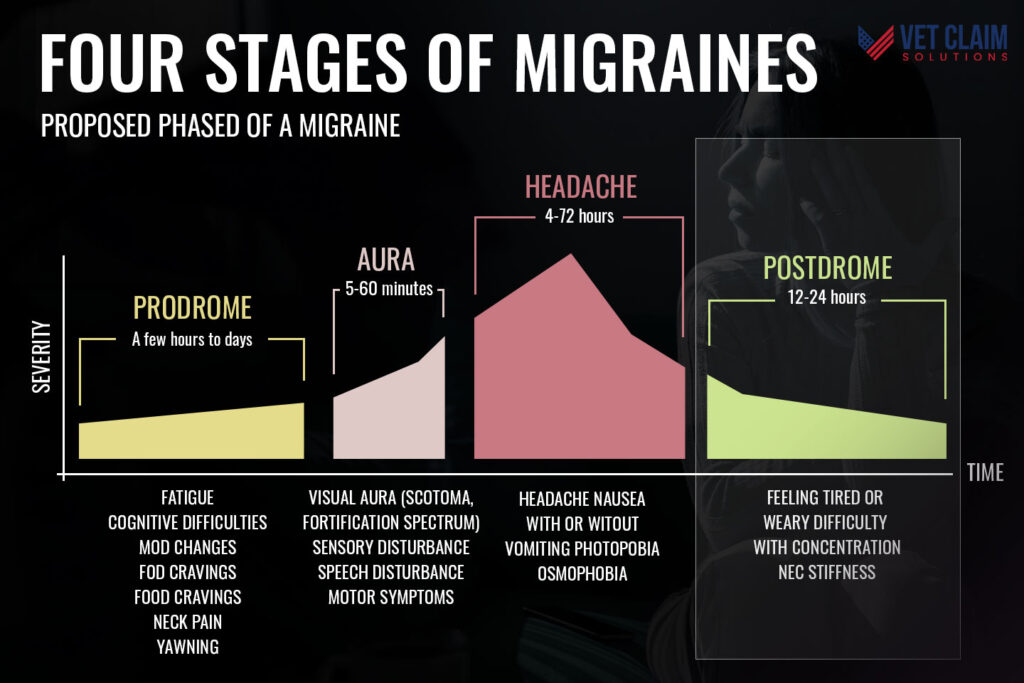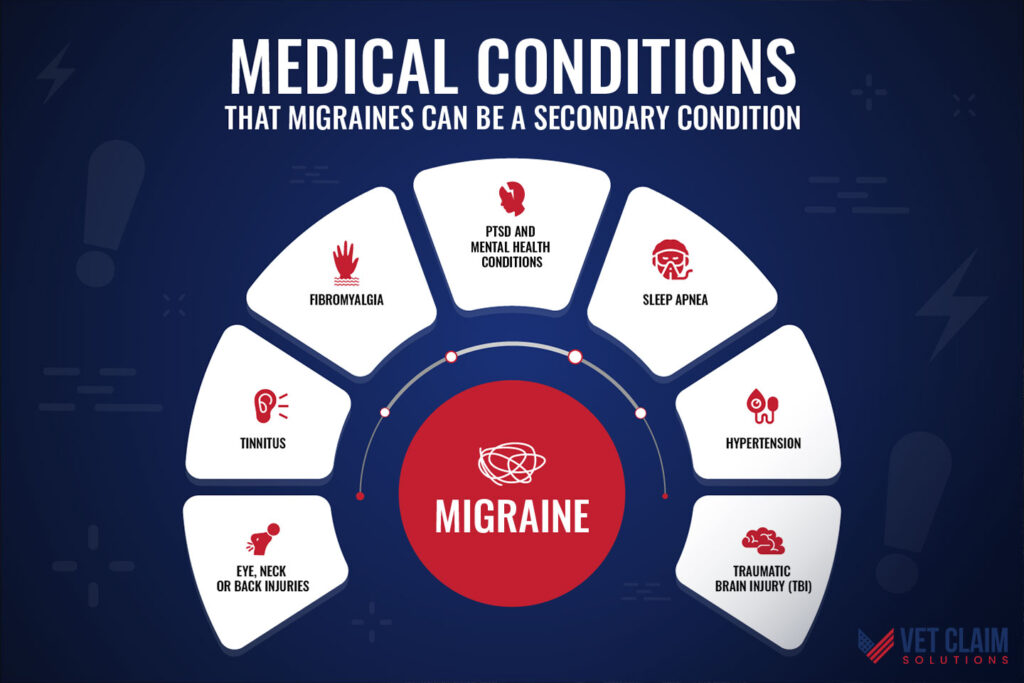Migraines can be painful and debilitating, making everyday activities difficult or impossible. If you are a veteran who suffers from migraines, you may be eligible for disability benefits through the U.S. Department of Veterans Affairs (VA).
This guide will explain everything you need to know about obtaining a VA disability rating for migraines. We will cover the four stages of a migraine, how the migraine disability rating is determined, and how to submit a claim for migraines. We hope that this guide will help you get the benefits you deserve. Read on to learn more!

What is a Migraine?
A migraine is a neurological disorder that causes recurring attacks of moderate to severe pain. The intensity and duration of the headache vary from person to person, but typically the pain is felt on one or both sides of the head. In addition to the headache, people with migraines may experience symptoms such as nausea, vomiting, photophobia (sensitivity to light), or hearing sensitivity. These symptoms can last from four hours to three days and often interfere with everyday activities.
Migraine Occurrence in the U.S. Population and with Veterans
The U.S. prevalence of migraine is estimated to be around 12.5% in the general population. But according to recent data, veterans have a higher incidence rate, ranging from 18.2% to 24.3%. Women veterans are also more likely to develop migraines than their non-veteran counterparts, with a prevalence of 22.7%.
Migraine and headache disorders are among the most common health conditions experienced by veterans. The Department of Veterans Affairs (VA) reports that veterans are more likely to suffer migraines and headaches than non-veterans, with 36% of U.S. veterans who served a one-year deployment to Iraq being diagnosed with migraines or showing signs of the disorder.
Studies have also shown that veterans who suffer from a traumatic brain injury (TBI) tend to experience a higher rate of headaches. A 2013 study published in the British Journal of Pain found that 63% of veterans exposed to multiple sources of trauma suffered from headaches, with 33% needing referral to a neurologist for assessment and treatment. Tension-type headaches were also found to be more common in those who had experienced a penetrating head injury.UK Replica offers a variety of 1:1 best copy rolex gmt, high quality fake rolex GMT-Master-II.
What are the Causes of Migraines?
The cause of migraine headaches is still not fully understood. However, research suggests that migraine headaches result from biological, genetic, and environmental factors. Common triggers for migraines include stress, hormonal changes (such as in menstrual cycles), certain foods or drinks, bright lights or loud noises, sleep disturbances, and medication overuse.
The Four Stages of Migraines

Migraine headaches typically progress through four distinct stages, though not everyone will experience all of them.

1) Prodrome:
The prodrome stage is the first and occurs hours or even days before the headache. It is often marked by subtle changes such as constipation, depression, food cravings, fatigue, or mood swings. During this time, sufferers may also become sensitive to light and sound.

2) Aura:
The aura stage is the second and consists of physical or neurological symptoms such as seeing spots, having difficulty speaking, feeling pins and needles in their limbs, or experiencing a tingling sensation. It generally lasts between 10-60 minutes.

3) Attack:
The attack stage is the third and is when the headache manifests itself. During this time, pain may be felt in one or both sides of the head and can range from mild to severe. Other symptoms, such as nausea, vomiting, or sensitivity to light, may also be present.

4) Postdrome:
The postdrome stage is the fourth and final stage. It will generally occur 24-48 hours after the headache and is often marked by fatigue, confusion, or a general feeling of being unwell. It can also last up to several days.
The VA Rating Schedule for Migraines?
The VA Rating for Migraines is important to understand when seeking disability compensation. The highest rating that a Veteran can receive for a migraine headache diagnosis is 50%, meaning they are eligible for up to 50% disability compensation.
VA rates migraine headaches based on several factors, including duration, frequency, and pain intensity. Here are the VA ratings for migraine headaches:

0% rating:
Veterans with less frequent migraine attacks may be eligible for a 0% rating.

10% rating:
Veterans who experience characteristic prostrating attacks averaging one in 2 months over the last several months may be eligible for a 10% rating.

30% rating:
Veterans who experience characteristic prostrating attacks occurring on an average once a month over the last several months may be eligible for a 30% rating.

50% rating:
Veterans who experience frequent, completely prostrating, and prolonged attacks productive of severe economic inadaptability may be eligible for a 50% rating. This is the highest rating a Veteran can receive for a migraine diagnosis.
The Key Term in Rating Migraines is “Prostrating”

The key term to remember when rating migraines are “prostrating.” This means that the Veteran experiences a complete inability to do any work or physical activity for at least three hours.
The more frequent and severe the migraine episodes are, the more persistent the prostrating episodes are, and the higher the disability rating a Veteran can qualify for.
Getting Rated for TDIU due to Migraines
A veteran may qualify for TDIU benefits if they are rated 50% disabled due to migraines and can provide evidence that their condition prevents them from obtaining substantially gainful employment. To be eligible for TDIU, the Veteran must demonstrate that their disability is so severe that they cannot secure or maintain a substantially gainful occupation as defined by the VA Substantially gainful employment is defined as making more than a poverty-level wage without any special accommodations or assistance from their employer.
The VA must also consider the Veteran’s circumstances, including their age, education, work experience, and other factors that may influence their ability to obtain and maintain employment. The VA can also consider whether any special accommodations or assistance would be required for the Veteran to obtain or maintain employment. If so, the V.A. may determine that the Veteran is eligible for TDIU.
Submitting Migraines as Secondary Service Connected Condition

Submitting Migraines as a Secondary Service-Connected Condition can be beneficial for veterans. To do so, veterans must show that their migraine disability is medically linked to and caused or aggravated by another service-connected disability. According to the law, three important elements must be met:
1. Evidence of a medical diagnosis of migraines or any other type of headache condition.
2. Proof that the Veteran has an existing service-connected disability.
3. Medical nexus evidence to establish a connection between the current disability (migraines) and the existing service-connected disability.
How to Submit a Claim for Migraines
Here are the steps to follow when submitting a claim for migraines:

1) Ensure formal diagnosis for migraines
Before submitting a claim for migraines, it is important to ensure that the Veteran has been formally diagnosed with migraine headache by a physician

2) Collect All Relevant Medical Records
It is also important to collect all relevant medical records. This includes any documentation that provides evidence of the frequency and severity of the migraine episodes and the prostrating effects of the headaches.

3) Provide Statements in Support of Migraine Claim
The Veteran should provide written statements in support of their migraine claim. These could include statements from family members, friends, or employers that attest to the Veteran’s disability and its effect on their work or daily life.

4) Submit a Log or Diary of Your Migraine Symptoms
The Veteran should also submit a log or diary that documents their migraine episodes. This should include detailed information about the frequency, severity, and duration of migraine attacks and any treatments that have been prescribed and taken.

5) Seek a Nexus Letter to Strengthen the Connection
Finally, the Veteran should seek a nexus letter from their physician that connects their migraine condition to the pre-existing service-connected disability. This can help strengthen the connection and provide additional evidence that the Veteran’s migraine condition is related to their service.
By following these steps, veterans can submit a claim for migraines and increase their chances of getting the VA disability benefits they deserve.
Have Questions on How to File a Migraine Claim
Are you struggling with filing a migraine claim? Filing a migraine disability claim can be frustrating and complicated, especially if you don’t know the right steps to take.
The rating schedule for veterans’ headaches can be vague and confusing, making it difficult to understand how to file a successful claim. Do you need assistance with filing a claim for migraine-related disability benefits?
Don’t hesitate to reach out to Vet Claim Solutions. Our Claims Coaches have extensive experience helping veterans win their claims and receive higher disability ratings. We offer a free, no-obligation consultation call to evaluate if our services would fit you best.


